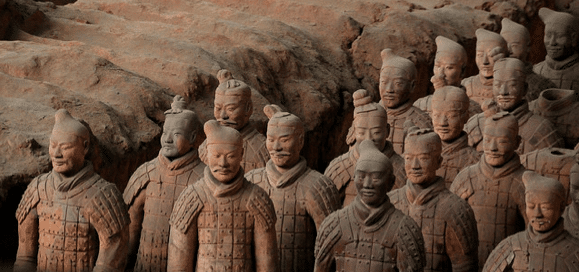
Prehistory
Archaeological evidence suggests that early hominids inhabited China between 2.24 million and 250,000 years ago. The hominid fossils of Peking Man, a Homo erectus who used fire, were discovered in a cave at Zhoukoudian near Beijing; they have been dated to between 680,000 and 780,000 years ago.The fossilized teeth of Homo sapiens (dated to 125,000–80,000 years ago) have been discovered in Fuyan Cave in Dao County, Hunan. Chinese proto-writing existed in Jiahu around 7000 bce, Damaidi around 6000 bce, Dadiwan from 5800–5400 bce, and Banpo dating from the 5th millennium bce. Some scholars have suggested that the Jiahu symbols (7th millennium bce) constituted the earliest Chinese writing system.
Early dynastic rule

According to Chinese tradition, the first dynasty was the Xia, which emerged around 2100 bce. The dynasty was considered mythical by historians until scientific excavations found early Bronze Age sites at Erlitou, Henan in 1959. It remains unclear whether these sites are the remains of the Xia dynasty or of another culture from the same period. The succeeding Shang dynasty is the earliest to be confirmed by contemporary records.The Shang ruled the plain of the Yellow River in eastern China from the 17th to the 11th century bce. Their oracle bone script (from c. 1500 bce) represents the oldest form of Chinese writing yet found, and is a direct ancestor of modern Chinese characters. The Shang were conquered by the Zhou, who ruled between the 11th and 5th centuries bce, though centralized authority was slowly eroded by feudal warlords. Many independent states eventually emerged from the weakened Zhou state and continually waged war with each other in the 300-year Spring and Autumn period, only occasionally deferring to the Zhou king. By the time of the Warring States period of the 5th–3rd centuries bce, there were seven powerful sovereign states in what is now China, each with its own king, ministry and army.
Imperial China
The Warring States period ended in 221 bce after the state of Qin conquered the other six kingdoms and established the first unified Chinese state. Its King Zheng proclaimed himself the First Emperor of the Qin dynasty (Qín Shǐhuáng or Shǐ Huángdì). He enacted Qin's legalist reforms throughout China, notably the forced standardization of Chinese characters, measurements, road widths (i.e., cart axles' length), and currency. His dynasty also conquered the Yue tribes in Guangxi, Guangdong, and Vietnam. The Qin dynasty lasted only fifteen years, falling soon after the First Emperor's death, as his harsh authoritarian policies led to widespread rebellion.
Following a widespread civil war during which the imperial library at Xianyang was burned, the Han dynasty emerged to rule China between 206 bce and ce 220, creating a cultural identity among its populace still remembered in the ethnonym of the Han Chinese. The Han expanded the empire's territory considerably, with military campaigns reaching Central Asia, Mongolia, South Korea, and Yunnan, and the recovery of Guangdong and northern Vietnam from Nanyue. Han involvement in Central Asia and Sogdia helped establish the land route of the Silk Road, replacing the earlier path over the Himalayas to India. Han China gradually became the largest economy of the ancient world. Despite the Han's initial decentralization and the official abandonment of the Qin philosophy of Legalism in favor of Confucianism, Qin's legalist institutions and policies continued to be employed by the Han government and its successors.
After the collapse of Han, a period of strife known as Three Kingdoms followed, whose central figures were later immortalized in one of the Four Classics of Chinese literature. At its end, Wei was swiftly overthrown by the Jin dynasty. The Jin fell to civil war upon the ascension of a developmentally-disabled emperor; the Five Barbarians then invaded and ruled northern China as the Sixteen Kingdoms. The Xianbei unified them as the Northern Wei, whose Emperor Xiaowen reversed his predecessors' apartheid policies and enforced a drastic sinification on his subjects, largely integrating them into Chinese culture. In the south, the general Liu Yu secured the abdication of the Jin in favor of the Liu Song. The various successors of these states became known as the Northern and Southern dynasties, with the two areas finally reunited by the Sui in 581. The Sui restored the Han to power through China, reformed its agriculture and economy, constructed the Grand Canal, and patronized Buddhism. However, they fell quickly when their conscription for public works and a failed war with Korea provoked widespread unrest.
Under the succeeding Tang and Song dynasties, Chinese economy, technology, and culture entered a golden age. The Tang Empire returned control of the Western Regions and the Silk Road, and made the capital Chang'an a cosmopolitan urban center. However, it was devastated and weakened by the An Shi Rebellion in the 8th century. In 907, the Tang disintegrated completely when the local military governors became ungovernable. The Song Dynasty ended the separatist situation in 960, leading to a balance of power between the Song and Khitan Liao. The Song was the first government in world history to issue paper money and the first Chinese polity to establish a permanent standing navy which was supported by the developed shipbuilding industry along with the sea trade. Between the 10th and 11th centuries, the population of China doubled in size to around 100 million people, mostly because of the expansion of rice cultivation in central and southern China, and the production of abundant food surpluses. The Song dynasty also saw a revival of Confucianism, in response to the growth of Buddhism during the Tang, and a flourishing of philosophy and the arts, as landscape art and porcelain were brought to new levels of maturity and complexity. However, the military weakness of the Song army was observed by the Jurchen Jin dynasty. In 1127, Emperor Huizong of Song and the capital Bianjing were captured during the Jin–Song Wars. The remnants of the Song retreated to southern China.
In the 13th century, China was gradually conquered by the Mongol Empire. In 1271, the Mongol leader Kublai Khan established the Yuan dynasty; the Yuan conquered the last remnant of the Song dynasty in 1279. Before the Mongol invasion, the population of Song China was 120 million citizens; this was reduced to 60 million by the time of the census in 1300. A peasant named Zhu Yuanzhang overthrew the Yuan Dynasty in 1368 and founded the Ming dynasty. Under the Ming Dynasty, China enjoyed another golden age, developing one of the strongest navies in the world and a rich and prosperous economy amid a flourishing of art and culture. It was during this period that Zheng He led voyages throughout the world, reaching as far as Africa. In the early years of the Ming Dynasty, China's capital was moved from Nanjing to Beijing. With the budding of capitalism, philosophers such as Wang Yangming further critiqued and expanded Neo-Confucianism with concepts of individualism and equality of four occupations. The scholar-official stratum became a supporting force of industry and commerce in the tax boycott movements, which, together with the famines and the wars against Japanese invasions of Korea and Manchu invasions, led to an exhausted treasury.
In 1644, Beijing was captured by a coalition of peasant rebel forces led by Li Zicheng. The last Ming Chongzhen Emperor committed suicide when the city fell. The Manchu Qing dynasty, then allied with Ming dynasty general Wu Sangui, overthrew Li's short-lived Shun dynasty and subsequently seized control of Beijing, which became the new capital of the Qing dynasty.
End of dynastic rule

The Qing dynasty, which lasted from 1644 until 1912, was the last imperial dynasty of China. Its conquest of the Ming (1618–1683) cost 25 million lives and the economy of China shrank drastically. After the Southern Ming ended, the further conquest of the Dzungar Khanate added Mongolia, Tibet and Xinjiang to the empire.The centralized autocracy was strengthened to crack down on anti-Qing sentiment with the policy of valuing agriculture and restraining commerce, the Haijin ("sea ban"), and ideological control as represented by the literary inquisition, causing social and technological stagnation. In the mid-19th century, the dynasty experienced Western imperialism in the Opium Wars with Britain and France. China was forced to pay compensation, open treaty ports, allow extraterritoriality for foreign nationals, and cede Hong Kong to the British under the 1842 Treaty of Nanking, the first of the Unequal Treaties. The First Sino-Japanese War (1894–95) resulted in Qing China's loss of influence in the Korean Peninsula, as well as the cession of Taiwan to Japan.
The Qing dynasty also began experiencing internal unrest in which tens of millions of people died, especially in the failed Taiping Rebellion that ravaged southern China in the 1850s and 1860s and the Dungan Revolt (1862–77) in the northwest. The initial success of the Self-Strengthening Movement of the 1860s was frustrated by a series of military defeats in the 1880s and 1890s.
In the 19th century, the great Chinese diaspora began. Losses due to emigration were added to by conflicts and catastrophes such as the Northern Chinese Famine of 1876–79, in which between 9 and 13 million people died. In 1898, the Guangxu Emperor drafted a reform plan to establish a modern constitutional monarchy, but these plans were thwarted by the Empress Dowager Cixi. The ill-fated anti-foreign Boxer Rebellion of 1899–1901 further weakened the dynasty. Although Cixi sponsored a program of reforms, the Xinhai Revolution of 1911–12 brought an end to the Qing dynasty and established the Republic of China.
Republic of China (1912–49)

On 1 January 1912, the Republic of China was established, and Sun Yat-sen of the Kuomintang (the KMT or Nationalist Party) was proclaimed provisional president. However, the presidency was later given to Yuan Shikai, a former Qing general who in 1915 proclaimed himself Emperor of China. In the face of popular condemnation and opposition from his own Beiyang Army, he was forced to abdicate and re-establish the republic.
After Yuan Shikai's death in 1916, China was politically fragmented. Its Beijing-based government was internationally recognized but virtually powerless; regional warlords controlled most of its territory. In the late 1920s, the Kuomintang, under Chiang Kai-shek, the then Principal of the Republic of China Military Academy, was able to reunify the country under its own control with a series of deft military and political manoeuvrings, known collectively as the Northern Expedition. The Kuomintang moved the nation's capital to Nanjing and implemented "political tutelage", an intermediate stage of political development outlined in Sun Yat-sen's San-min program for transforming China into a modern democratic state. The political division in China made it difficult for Chiang to battle the Communist, People's Liberation Army (PLA) against whom the Kuomintang had been warring since 1927 in the Chinese Civil War. This war continued successfully for the Kuomintang, especially after the PLA retreated in the Long March, until Japanese aggression and the 1936 Xi'an Incident forced Chiang to confront Imperial Japan.
The Second Sino-Japanese War (1937–1945), a theater of World War II, forced an uneasy alliance between the Kuomintang and the PLA. Japanese forces committed numerous war atrocities against the civilian population; in all, as many as 20 million Chinese civilians died. An estimated 200,000 Chinese were massacred in the city of Nanjing alone during the Japanese occupation. During the war, China, along with the UK, the US and the Soviet Union, were referred to as "trusteeship of the powerful"and were recognized as the Allied "Big Four" in the Declaration by United Nations. Along with the other three great powers, China was one of the four major Allies of World War II, and was later considered one of the primary victors in the war. After the surrender of Japan in 1945, Taiwan, including the Pescadores, was returned to Chinese control. China emerged victorious but war-ravaged and financially drained. The continued distrust between the Kuomintang and the Communists led to the resumption of civil war. In 1947, constitutional rule was established, but because of the ongoing unrest, many provisions of the ROC constitution were never implemented in mainland China.
People's Republic of China (1949–present)

Major combat in the Chinese Civil War ended in 1949 with the Communist Party in control of most of mainland China, and the Kuomintang retreating offshore, reducing the ROC's territory to only Taiwan, Hainan, and their surrounding islands. On 1 October 1949, Communist Party Chairman Mao Zedong proclaimed the establishment of the People's Republic of China. In 1950, the People's Liberation Army succeeded in capturing Hainan from the ROC and incorporating Tibet. However, remaining Kuomintang forces continued to wage an insurgency in western China throughout the 1950s.
The regime consolidated its popularity among the peasants through land reform, which saw between 1 and 2 million landlords executed. Under its leadership, China developed an independent industrial system and its own nuclear weapons.The Chinese population almost doubled from around 550 million to over 900 million. However, the Great Leap Forward, a large-scale economic and social reform project, resulted in an estimated 45 million deaths between 1958 and 1961, mostly from starvation. In 1966, Mao and his allies launched the Cultural Revolution, sparking a decade of political recrimination and social upheaval which lasted until Mao's death in 1976. In October 1971, the PRC replaced the Republic of China in the United Nations, and took its seat as a permanent member of the Security Council.
After Mao's death, the Gang of Four was quickly arrested and held responsible for the excesses of the Cultural Revolution. In 1978 Deng Xiaoping took power and instituted significant economic reforms. The Communist Party loosened governmental control over citizens' personal lives, and the communes were gradually disbanded in favor of private land leases. This marked China's transition from a planned economy to a mixed economy with an increasingly open market environment. China adopted its current constitution on 4 December 1982. In 1989, the violent suppression of student protests in Tiananmen Square brought condemnation and sanctions against the Chinese government from various countries.
Jiang Zemin, Li Peng and Zhu Rongji led the nation in the 1990s. Under their administration, China's economic performance pulled an estimated 150 million peasants out of poverty and sustained an average annual gross domestic product growth rate of 11.2%. The country formally joined the World Trade Organization in 2001, and maintained its high rate of economic growth under Hu Jintao and Wen Jiabao's leadership in the 2000s. However, rapid growth also severely impacted the country's resources and environment, and caused major social displacement. Living standards continued to improve rapidly despite the late-2000s recession, but centralized political control remained tight.
Preparations for a decadal Communist Party leadership change in 2012 were marked by factional disputes and political scandals. During China's 18th National Communist Party Congress in November 2012, Hu Jintao was replaced as General Secretary of the Communist Party by Xi Jinping. Under Xi, the Chinese government began large-scale efforts to reform its economy,which has suffered from structural instabilities and slowing growth.The Xi–Li Administration also announced major reforms to the one-child policy and prison system.












